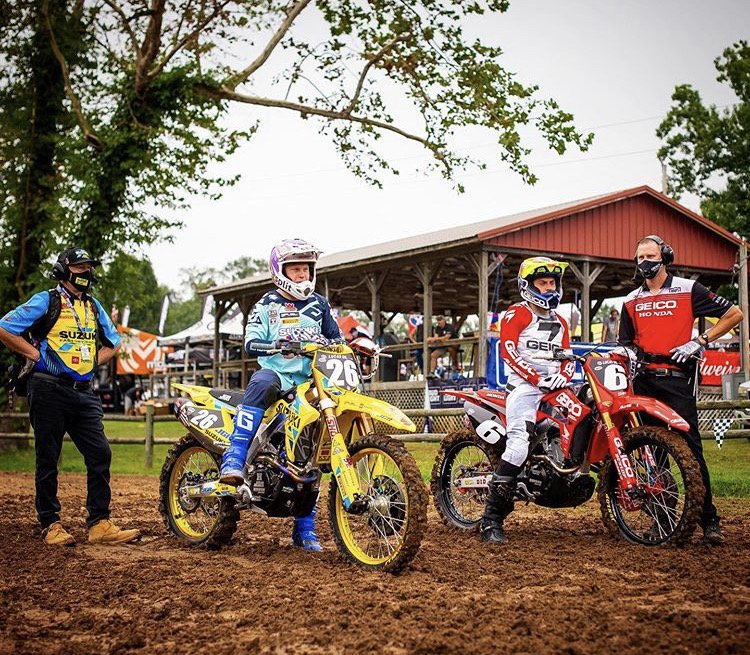how much do pro racers actually train?
Jeremy and I before the first Pro Motocross race held at Loretta Lynn’s in 2020.
It’s no secret that you must be in incredible shape to ride a dirt bike fast, safely, and effectively at the pro level for two 35-minute motos. Especially on a hot, humid summer day! Motocross demands a very high level of cardiovascular fitness, strength, mobility, and mental toughness. At the Ironman National, MXA highlighted how Jo Shimoda only did five laps of practice that week. He went 1-1 on the day for the 250 class overall. Let’s dig into how a guy like Jo can ride so little during the week but perform amazingly at the end of the motocross season.
How much are these PRO guys actually riding on a weekly and monthly basis?
A typical factory rider starts his offseason training no later than November 1st. During the offseason, there is a TON of testing going on, but also many motos to put the suspension, chassis, and engine setups through the paces. On average, they put in 4-6 main event (15 minutes+1 lap for 250s and 20 minutes +1 lap for 450s) motos weekly. If a guy is racing West Coast SX, by the time he gets to the starting gate at Anaheim in January, he’s looking at having roughly 40+ main event motos in the bank. Fast forward to the end of the Supercross season in May, and these guys have logged another 80+ main event motos between racing and practicing.
The same goes for the motocross season, as there is usually a one or two-week break in the schedule. Most pros will take a day or two off before going into outdoor prep. One perk of being a regional 250 sx guy is you can usually get some early track time outdoors when there's a break in the schedule. After a summer filled with training 2-3 days a week on the bike and racing 11 pro motocross nationals on the weekends, by the time these guys get to the Ironman National in late August, they’ve put their bodies through another 50, 35-minute motos! Now, this number would be much higher for a guy like Jeffrey Herlings, who’s been rumored to do as many as 15 40-minute motos in a single week! But that’s a whole different story for another day.
Let’s also not forget that the top-level factory guys put in many hours each week cycling, running, rowing, in the gym, and sitting on a plane 50-60 days out of the year as they travel and race around the country. As a recently retired racer who did this grind for the last 15 years, I can attest that this sport takes a physical and mental toll on a guy!
So, in getting back to Jo Shimoda, only riding five laps the week leading up to the Ironman National. At this point in the season, he will not forget how to ride his dirt bike. He has logged hundreds of hours and thousands of laps by the time he rolls up to that start gate, and he is actually benefiting from finally giving his body a rest!
Professional motocross athletes have raised the bar very high in the fitness department over the last decade. To compete for wins and podiums, they must train hard to be competitive.
My point with laying all of this out is that A, this sport is gnarly, and B, rest, and recovery are very important for surviving a schedule like this year after year. But there is a time during one's season to put in the work and grind it out, and there is a time when you need to listen to your body and take it easy. Recovery is as crucial as training itself. Without adequate rest and recovery, the body cannot adapt to the physical demands of the sport. Here are some essential aspects of recovery:
Rest Days: Scheduled rest days allow the body to recover, repair muscle tissue, and replenish energy stores. Skipping these days in pursuit of more training can be counterproductive.
Nutrition: Proper nutrition is vital to recovery. Athletes should consume a balanced diet rich in carbohydrates, protein, and healthy fats to support muscle repair and overall energy levels.
Sleep: Quality sleep is when the body undergoes most of its repair and regeneration. Athletes should aim for 7-9 hours of restful sleep per night.
Active Recovery: Light exercises, such as stretching or yoga, can aid in recovery by increasing blood flow and reducing muscle soreness.
In conclusion, overtraining can significantly hinder one's performance on race day. Excessive training can lead to bad races, injuries, and a plateau in performance. It's crucial for athletes to prioritize recovery, listen to their bodies, and adopt a well-structured training plan to achieve their best results on the track. Remember, success isn't solely about working harder; it's about working smarter and finding the right balance between training and recovery. Truly, sometimes the best thing an athlete can do is sit on the couch. Thanks for reading!
![TROLL TRAIN[ING]](http://images.squarespace-cdn.com/content/v1/5fb89fd14197c65de33d5cb9/1607057857753-VC70KC2K4M7VJXBOTQSW/Asset+6.png?format=1500w)
![TROLL TRAIN[ING]](http://images.squarespace-cdn.com/content/v1/5fb89fd14197c65de33d5cb9/1607057862444-OWBDH7DLC7X39TLYLMHJ/Asset+6.png?format=1500w)
